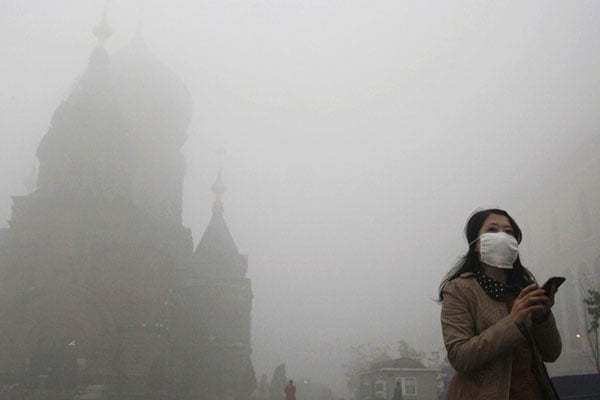
Attacked by activists and lambasted by locals, Beijing’s government this week declared its first red alert on atmospheric pollution. The air in the Chinese capital is less filled by noxious fumes and dust than last week but the city finally responded to discontent and anger among its 20m citizens by shutting schools, closing factories and construction sites, and making car owners drive on alternate days.
Beijing’s air at the end of November reached 40 times the World Health Organisation’s safe limit for tiny particles of dust and soot that can penetrate human lungs. China’s cities are rivalled in foul air by India’s. An alternate-day ban on cars is planned for New Delhi in January after 13 Indian cities were ranked by the WHO in the top 20 most choked metropolises in the world.
The blankets of smog that regularly cover cities in China and India are a product of both industrialisation and urbanisation. Their economies and cities have grown so fast that they cannot cope. Fogs filled with nitrous oxide, sulphur dioxide, mineral dust and black carbon are asphyxiating citizens, contributing to cancer, lung disease and the premature deaths of millions. But smog is also a symptom of maladministration and corruption - a lack of will to limit polluting factories, diesel vehicles and coal-fired power plants because politicians and officials are too docile and biddable. There are alternatives, from natural gas power plants to electric vehicles, but these cities stink of vested interests.
The same sclerosis afflicted London in the 19th and early 20th centuries. “London is a vile place,” Charles Dickens wrote in 1851. “Whenever I come back from the country now, and see that great heavy canopy lowering over the house tops, I wonder what on earth I do there, except on obligation.”
The city’s Victorian growth and its place at the heart of global trade brought ships to port, millions to work in factories, and the lighting of thousands of coal fires. It produced, as Christine Corton records in her book London Fog, the sulphur-infused, yellow-brown smog that characterised the city. This week is the anniversary of the great smog of 1952, which killed up to 12,000 Londoners and changed attitudes.
Dickens wrote of fog in Our Mutual Friend. “In London, it was at about the boundary line dark yellow, and a little within it brown, and then browner, and then browner, until at the heart of the City . . . it was rusty-black.” Rust was a Victorian metaphor for money, especially corrupt money, and wealth held back efforts to clean up London’s air until the 1956 Clean Air Act.
Although London was purged in other ways, notably by the sewers built by Joseph Bazalgette after the Great Stink pollution of the Thames in 1858, factory owners (and householders who kept warm by open fires) resisted reform until the 1950s. Only then did citizens, seeking a better postwar life, demand action.
Beijing’s red alert suggests a similar turning point in China - the government having to respond to its people. It is no longer tenable to ignore the fact that people need to wear face masks to stop inhaling poisonous dust. There is a growing awareness of the connection between government inertia and state-owned industries feeling free to carry on emitting air pollution.
Chai Jing, the Chinese television journalist, made the link explicit in her popular environmental documentary Under The Dome this year. After travelling to cities including London and Los Angeles to discover how they had tackled air pollution, she concluded that corruption and over-concentration of power at state-owned energy groups, such as China National Petroleum and Sinopec, have stifled progress.
“[China’s] government should not subsidise backward thinking, polluting, unprofitable businesses,” Ms Chai argues in her film, which was viewed more than 300m times after its release and prompted Li Keqiang, China’s premier, to describe pollution as “a blight on people’s quality of life and a trouble that weighs on their hearts”.
Malpractice is deep-rooted - 25 per cent of executives investigated for corruption in state-owned enterprises between 2012 and April this year as part of President Xi Jinping’s crackdown came from the energy sector. A lack of transparency and open tendering - and the scale and power of the industry - offers plenty of opportunity for official bribery and manipulation.
This encourages a tragedy of the commons - exploitation of the public resource of open air by vested interests, facilitated by weak regulators. Much of China’s electricity is produced by coal-fired power stations which emit more particles, nitrous oxide and sulphur dioxide than other energy sources. Beijing is trying to curb emissions but is overwhelmed by drifting pollution.
London has not eliminated the problem. One study suggested that the equivalent of 9,400 lives are still lost annually to air pollution, particularly from diesel fumes. But, along with Los Angeles and others, it realised the danger and managed to respond.
Many cities in developing countries cared little about the threat until now, but they can clean themselves up. The troubles of Beijing and New Delhi have demonstrated the urgency. By 2050, 6.3bn of the world’s 9bn people are expected to be living in urban areas and they will need to breathe. The world must not get lost in smog.
No comments:
Post a Comment